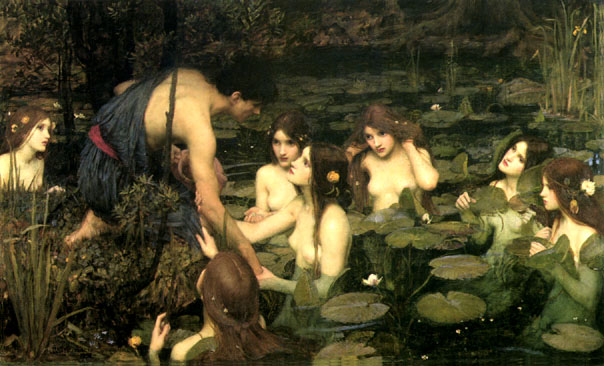

Picture credit: "Hylas and the Nymphs", J.W. Waterhouse
Water is a substance that permeates mythology the world over. Given the fact that roughly 75% of our planet is submerged, not to mention the fact that humans couldn't survive without water, it isn't surprising to find water-based stories and legends everywhere, recording both our dependence on water and the things which inhabit it, as well as our fear of the sea and our fascination with strange creatures of the deep.
Perhaps the most deadly of all water creatures are the mermaids, nymphs, and other fishy half-human sprites which inhabit bodies of water ranging from mountain lakes to the open sea. The image of a seductive, half-nude fish-woman sitting on a rock, singing strange songs, luring sailors towards certain death, is a very powerful image. It illustrates to us the power that sexual attraction has over people, and its potential destructiveness. The Sirens of Greek mythology nearly drove Odysseus mad with their singing, and had he not had the good sense to block his shipmates' ears with cotton, his voyage would have ended on the rocks, so to speak.
The connection with sexuality, fertility, and the sea is a very old one. The earliest stories about the birth of the Greek Love-Goddess, Aphrodite, are highly sexual. Her conception began when Zeus did battle with his father, Cronos; Zeus eventually castrated the older god and threw his mutilated genitals into the ocean. The sea immediately foamed and bubbled, and from that foam stepped Aphrodite, born of the bountiful ferocity of the oceans and the intensely powerful fertility of Cronos (I, personally, am amazed at a guy who can conceive even when his genitalia aren't attached to his body).
Not all water fairies live in the open ocean, however, and not all of their deadly appeal is intentional. It is true that such beings as the Lorelei, who inhabit the rivers of Germany, are considered to be heartless creatures whose one purpose in life is the destruction of lovelorn sailors; but many water sprites (particularly those that live in bodies of fresh water) are actually very shy, gentle folk who shun mankind. One variety of sprite, known as the Asrai, come to the surface only once every century to gaze at the full moon, for it is said that only by its light are they able to grow in size. Asrai stay far away from men, if they can, but when one is accidentally caught in some hapless fisherman's net, the Asrai's beauty is so delicate and enchanting that he cannot let her go. Stories are told, also, of Irish mermaids, who surface now and again, and can be captured against their will if one is able to steal their caps. The Water Maidens of Spain are bolder, and have the ability to walk about on land for a period of time; but they, too, are not interested in the seduction of men, and always return to their watery homes.
Nymphs, too, may or may not be dangerous. Nymphs come from Greek mythology; in general, a nymph is any perpetually young, ever-lovely sprite. Nymphs tend to live in places such as woodlands, forests, streams, or any other relatively wild, far-removed, natural location. Dryads and hamadryads are tree-nymphs, while the ocean nymphs who attended Poseidon were known as Nereids. The primal Greek god, Dionysus, was accompanied by a number of wild nymphs known as the Maenads, who performed his feral rituals in a drunken frenzy. Nymphs in general reside in places where men are few and far between. But their beauty is renowned. Nymphs such as Metis (the mother of Athena) and Maia (the mother of Hermes) attracted Zeus himself, although it must be noted that Zeus had the tendency to snark anything that was even vaguely feminine and incredibly beautiful. The danger of being charmed by a nymph, as with other freshwater sprites, seems to lie not so much in their powers of attraction and purposeful seduction; but in discovering their bewitching beauty largely by accident.